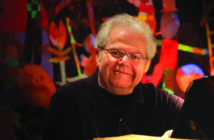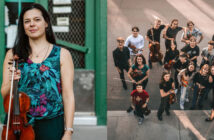With over a hundred recordings, thousands of concerts in halls all over the world, lauded appearances in festivals, collaborations with legendary artists such as Martha Argerich, Mischa Maisky, Yo-Yo Ma and Keith Jarrett and close ties to composers such as Philip Glass, Alfred Schnittke, Arvo Pärt, John Adams, Luigi Nono, Sofia Guibadulina, Valentin Silvestrov and Lera Auerback under his belt, Gidon Kremer’s career path is nothing short of astonishing. One could imagine that such a performer might be unapproachable, crisscrossing the globe, setting down his designer suitcases in the most luxurious of hotel suites, a man who has seen it all. It takes only two minutes into an interview with the violinist to see that, even at 63, he welcomes change in his artistic process. “I don’t have a recipe, but I always like to be surprised by others, to work with people and artists who have a vision,” he explains with rapid-fire delivery. “It is a great privilege to work with composers, to see how a piece that has never been heard before can come to life from the page.” Free of pretences, no ready-made formula: he finds it imperative that music reach the soul and speak directly to the heart. He lists off the artists who have most inspired him in one breath: Maria Callas, Jacques Brel and Leonard Bernstein, all artists who, according to him, “live music, let themselves be consumed by it.”
» Music as a First Language
As the son of professional members of the Lithuanian National Radio Orchestra, his mother half German, his father a Baltic Jew, and the grandson of the violinist, music teacher and Swedish music historian, Karl Brückner, it did not take long for young Gidon to discover the violin. “You will never amount to anything unless you first work tirelessly,” his father would say. And his mother would retort, “If you work tirelessly, you will have a better life,” he explains matter-of-factly in his autobiography Kindheitssplitter (Splinters of Childhood, not yet translated in English). “I don’t know either if I learned a lot from my grandfather. However, I am certain that his curiosity about all things new or original and his profound conviction that one must first hear a sound ‘within oneself’ before playing it helped forge the person I am today.” The young Gidon showed early on an insatiable curiosity, and this despite the long hours of practice and the scrutiny of not one but three authority figures. He devoured books, mastered checkers, was happily swept away by movies and even created “clubs” with his friends so they could converse, inquire and progress.
After completing his studies at the Riga School of Music, he was chosen to join the legendary class of David Oïstrakh at the Moscow Tchaikovsky Conservatory. Regional competitions piled up, but true recognition was yet to come. In 1965, he finally got his hands on the famous trophy he so coveted. “It took me a while to understand that in art, there can be no ‘victory,’ there can be no Olympic games with someone coming in first.” Next up were international competitions. In 1967, he won third prize at the Queen Elizabeth Music Competition in Belgium, and two years later, first prize at the Paganini Competition in Genoa. In 1970, his victory at the Tchaikovsky Competition confirmed his talent. “The violin was my guide and my torment. With it I learned over time to transform my loneliness, my dreams, my pain and my sense of humour into music. With my violin, I was searching for my key, my voice, my music.”
Almost compulsively, he devoured the great works of literature, fervently frequented theatres and studied Stanislavski. He kept writing, especially in his journal. “It is only through working that you can feel that you are in a visionary state of being. Life, for me, is in what you feel,” he writes on July 9, 1963. A few months later, barely an hour before going on stage for the second tour of the Republic Competition, he quickly jotted down: “I must, 1) think of Borisova [a theatre actress under whose spell he had fallen]; 2) bring joy to people; 3) convey the beauty of the piece; 4) think of what the composer wanted to express; 5) play for myself. In short—forget all of this and think of the music!” This passion for words continues to live in him and besides the autobiography of his early years he has published three works that reflect his artistic philosophy.
» Musician Without Borders
The musical fire that consumes Gidon Kremer wishes above all to be shared. “Being a violinist can be a little boring—especially for me,” he confided to a journalist some thirty years ago. In 1981, he founded Lockenhaus, an intimate chamber music festival that exists to this day. When he was 50, he decided to give himself a unique birthday present: gather up young musicians from the three Baltic states (Latvia, Lithuania and Estonia) for a summer, allow them to work with composers from the region and play with them. “I could never have imagined that Kremerata Baltica would become what it is today. When I met these young people and saw their intensity and their joy, I understood that from the very first summer, this was not something I could abandon. Today, after 14 years, they are a part of my family. Of course, over the years, a musician or two has been tempted to leave the ensemble, but in fact we have very little turnover. The majority are loyal members and I would say that the newcomers are even more so, because they are still bright-eyed, which allows the spirit of Kremerata Baltica to live on.” The 27-musician orchestra gives around fifty concerts per year, spread over five or six tours (including one of the Baltic states), records with glorious regularity (their last album, De profundis, came out in September) and it has been rewarded for its excellence on many occasions—in 2002, for example, After Mozart earned a Grammy and Germany’s ECHO prize. Wishing above all to prevent the “orchestritis” that too often affects professional musicians, Kremer prioritizes flexibility, a spirit of openness and a certain taste for risk. “I think that beyond the intimacy of the sound playing without a conductor helps us communicate with each other when we play a particularly complex piece, for example, Shostakovich’s Fourteenth Symphony.”
Refusing to maintain the status quo, he does not see himself as getting any older unless he stops a few seconds to contemplate his grey hair in the mirror. Really, he is still the same 17-year-old who noted, “My goal: bring, through music, more joy to people […]. For the moment, art is the only thing that can bring us joy, self-knowledge and energy.” The future of classical music does not particularly worry him. “I think that real music will survive, but, of course, there are many threats. In a sense, the commercialization of music cheapens its value, and people are often distracted by mediocre interpretations, by imitations, blinded by glitz and glamour. Sometimes, a star’s name overshadows the music that they perform. Our obligation is to the composer, to the music, not to get more credit than the true creators, but, as you know all too well, sales are based essentially on quantity, on the number of discs leaving the shelves. It’s a problem that Kremerata Baltica is trying to combat by remaining honest as much in our interpretations as in our choice of repertoire.”
He hopes to convince other musicians to follow suit, to resist the temptation of the easy route and the crossover trend. “I don’t think that music should be confined to a ghetto of connoisseurs, but I think that we have to fight to defend the interests of music, to not let commercial priorities tell us what sells.” But isn’t it a bit paradoxical to want simultaneously to reach out to the public by making recordings and remain a purist? “My priorities have never been oriented towards sales numbers or chart positions because, to paraphrase a familiar song, I’m not a material boy. I have the freedom to be able to make my own choices and I trust my own taste and beliefs. When I produce an album, I always put the emphasis on the music and not on the titles or the way the album will be presented.” The recording is the true work of art, and the booklet, cover and music must together form a whole: “The big labels are too worried about their sales numbers and, therefore, some of their covers, it’s sad to say, look a lot like pornography. I try to stay true to the values I grew up with. If someone understands this, great. If someone thinks it’s all too old-fashioned, too bad for him, but not for me.”
Montreal Programme
Kremerata Baltica´s Montreal programme will include three works: a string orchestra arrangement of Beethoven’s Quartet en do dièse mineur, Russian composer Lera Auerbach’s Sogno di Stabat Mater, for violin, viola, vibraphone and strings, and Giya Kancheli’s Silent Prayer, an interrupted meditation for violin, cello, vibraphone, bass guitar, chamber orchestra and tape. Says Gidon Kremer: “It’s Kagel who talked about composers who compose for other composers. This program has nothing to do with this statement. The composers we play all have something to say, are profoundly anchored in tradition, but possess their own individual voices. It is difficult to compare anything to Beethoven, especially his Quartet opus 131, ‘his Tenth Symphony,’ according to Bernstein, but composers are alive, vigorous and very sensitive. I am convinced that Beethoven was a man of his time, not indifferent to what was going on around him. It is critical not only to offer a breath of fresh air to the musicians of the orchestra, but also to allow the public to be surprised. That’s why I always try to build programmes that contain a certain bit of novelty. I’m not trying to be snobby by choosing these pieces; I don’t try to be excessively intellectual. I simply try to keep the music alive as much as possible. I hope that the Montreal audience will enjoy our performance.”
Translation: Lindsay Gallimore












